
A new definition of flamenco guitar as an instrument(November 2018)
|
||||||
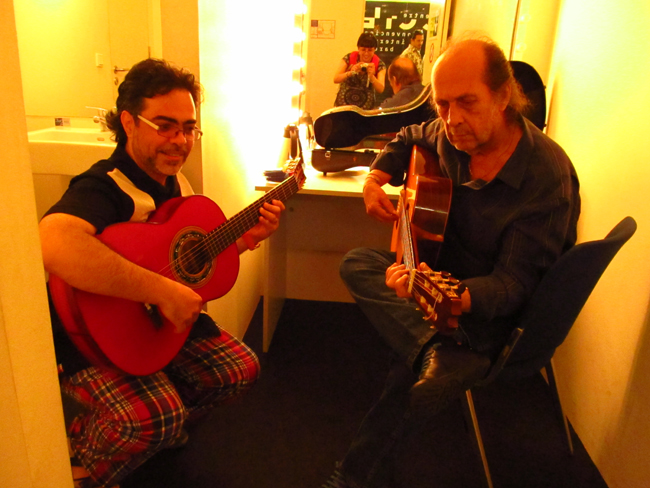 |
||||||
Part 1 |
||||||
Simplicio and his innovative idea (a separate double sound port for the top) |
||||||
| Video Synopsis - Part 1 | ||||||
It was around 1929 that our Stradivarius “The Stradivari of Spain”, the greatest Spanish luthier born in Barcelona. |
||||||
| Mr. Francisco Simplicio 1874-1933 http://harrisguitarfoundation.org/francisco-simplicio presented to the world nine very peculiar guitars, all of them of a new design with a top like this (picture taken from: http://andalusianguitars.com/FS1932-11-26.html) | ||||||
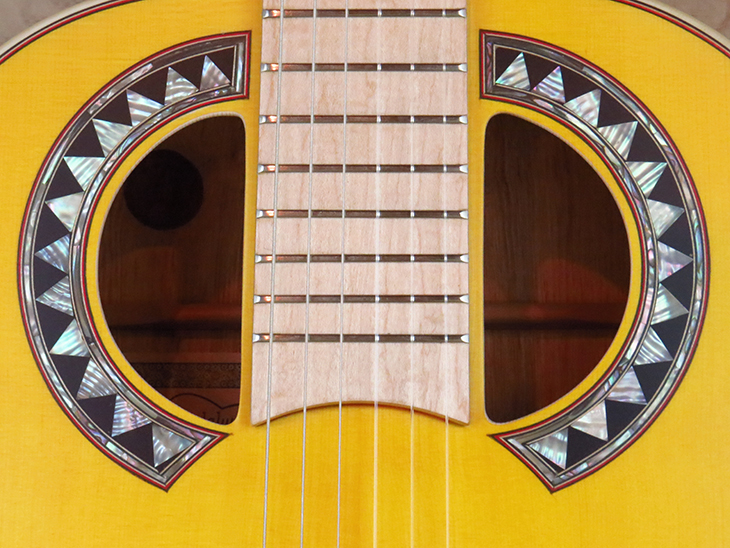 |
||||||
| Shaping -in that way- a fully renovated kind of Spanish guitar never seen before http://www.themomi.org/museum/mfa/popular_guitars/1929-30_F_Simplicio.html (Simplicio was also an expert in traditional guitar making and during his life he produced about 340 instruments ) The universality of Simplicio’s design applied to the newest flamenco guitars as it has been skillfully explored from many angles since 2015 by the creative master luthiers of AG http://andalusianguitars.com/aboutAG.html it represents a sublime redefinition of the modern flamenco guitar as an instrument, one that offers many tangible bonuses to anyone who plays a nylon string guitar no matter which style he plays, as well as for the modern flamenco guitar player. |
||||||
| After about 18 years of intense collaboration with AG as a trusted advisor in their projects (I still feel honored that Paco himself appointed me for that task), true is that AG has created a new concept of playability, envisioning a guitar with unparalleled exactness in tuning and design for the comfort of the player. In AG, the challenge during the research period was to create a guitar which could naturally reduce the difficult gaps there in every traditional guitar, inconsistences which are too often taken for granted as “normal things” by those who don’t know other than the monotonous same of the same feel and typical design of traditional flamenco guitars. In my opinion the centered sound whole concept altogether, the “traditional guitar design”representative of the Madrid school of guitar making has many obsolete features which remained unchanged certainly not to help the player, but to please the minds of those who belong to the “cult of the tradition” a cult of fellows sentimentally over attached to an outdated guitar design, same that has not been questioned or revisited for more than 100 years without even asking why is it so. |
||||||
| Unfortunately, at present many flamenco players in Spain are so acclimatized to those archaic features there that they can’t realize how all those gaps inherent to the traditional guitar design may be just huge obstacles to play efficiently and with ease. | ||||||
Amazingly enough Paco himself seemed also unfulfilled with traditional guitars as you can read from the following interview in 2013 (question n. 5, see this link https://goo.gl/8DSghE ) In the following video you can also see Paco himself saying again a similar thing: |
||||||
| To me, the Madrid school of guitar making is totally out-of-date, such guitars would be ok if one likes a masochistic feel of playing forced to deal with constant problems and hindrances one after the other. Paco used to say that some guys like to play just to be “beaten by their guitars”. Therefore, if anyone enjoys that, I have no problem with it, but this is not my case, how it could be? I consider myself fortunate to have listen Paco’s uncensored advices and many of his esoteric concepts about playability and guitars, I believe he told me things privately which he would never say publicly nor to tell anyone else about that at all. Admiring him as I still do, I trusted his points of view, and all that helped -directly and indirectly- to bring about this new concept of flamenco guitar making we have nowadays, with guitars like these: | ||||||
| Performing with efficiency is already difficult sometimes and, if the design of a guitar does not help the player, I can’t see what the gain is. To me, performing in such a contracted space is like playing with a pair of handcuffs on, having less and less possibilities to succeed over difficult passages of music like: |
||||||
| If that was not enough, one also have to deal with those innate handicaps regarding the sound delivery aspect which is very limited by the unidirectional way that traditional guitars can offer, it's important to be aware of the fact that such restrictions will be there even in the best traditional flamenco guitars. | ||||||
| On the other hand, Simplicio noticed several serious disadvantages of the traditional sound hole placement as he thought that it unavoidably weakens the guitar top in a very crucial area, this also causes a huge reduction of the sound emitting surface on the top (Huber, J.: The Development of the Modern Guitar, Westport, 1994, p.27) while an increased sound emitting surface would also improve the sound emitting platform in the bass range area (Stark, D.: Diplomarbeit – Entwurf und Bau einer Konzertgitarre mit doppelter Decke in Sandwichbauweise, Weimar, 2006, p.6). Influence on the sound: Omitting the centered sound hole and instead positioning that in a doubled manner both sides of the fingerboard as you can see here (picture taken from: http://andalusianguitars.com/FS1929-21-23.html) |
||||||
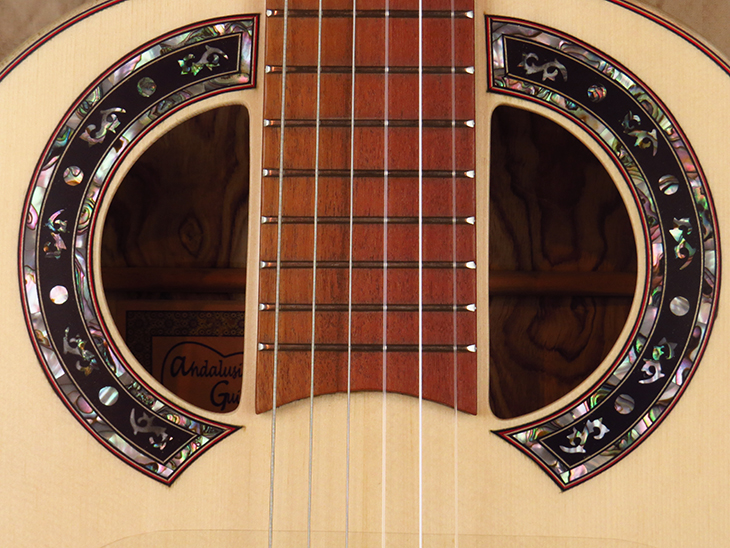 |
||||||
This leads to an enlarged vibrating surface of the top (sometimes cue to the ratio between top length or width and top thickness) and with that it is possible to: D) The AG simplicio 1929 model (Picture taken from: http://andalusianguitars.com/FS1932-2-shinglewood-hayab-%20cherryf-jacaranda-orangenat-11.html) |
||||||
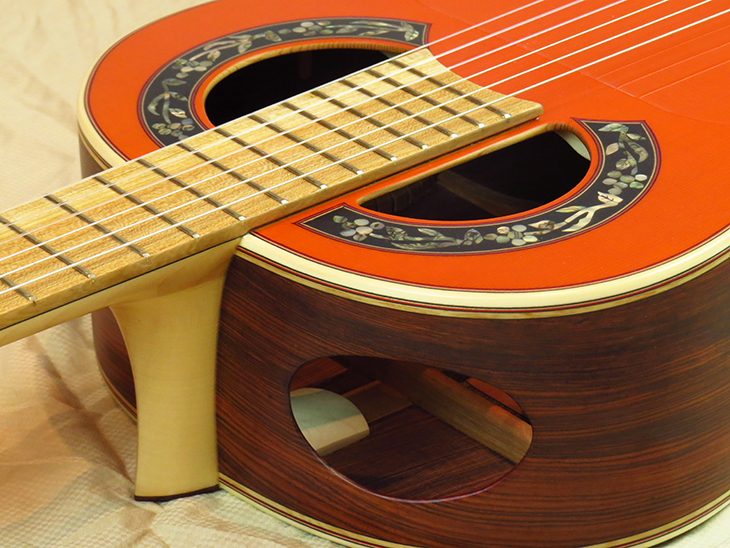 |
||||||
| as well as for its asymmetrical derivations: | ||||||
| E) A Picasso cut away desig (Picture taken from: http://andalusianguitars.com/FS1929-36-14.html) | ||||||
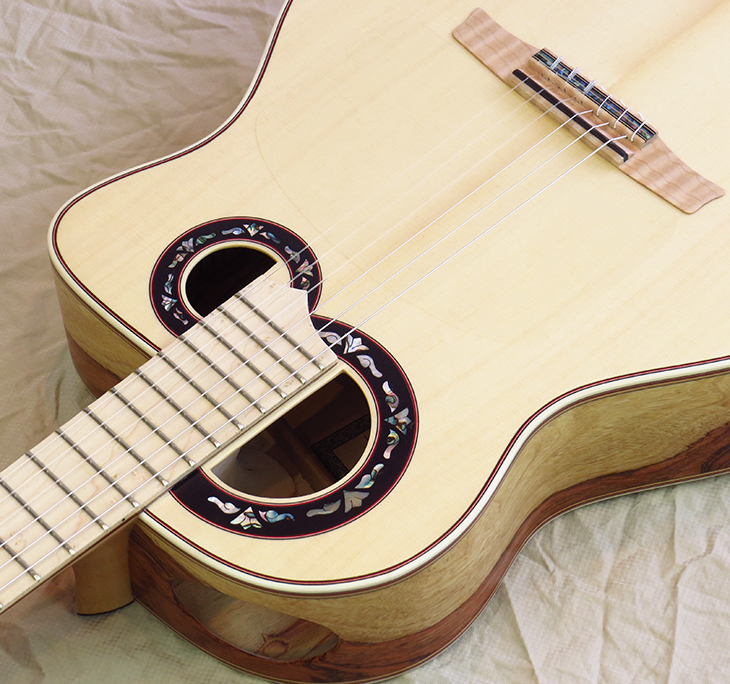 |
||||||
| F) Double cut away design (Picture taken from: http://andalusianguitars.com/FS1932-7-11.html) |
||||||
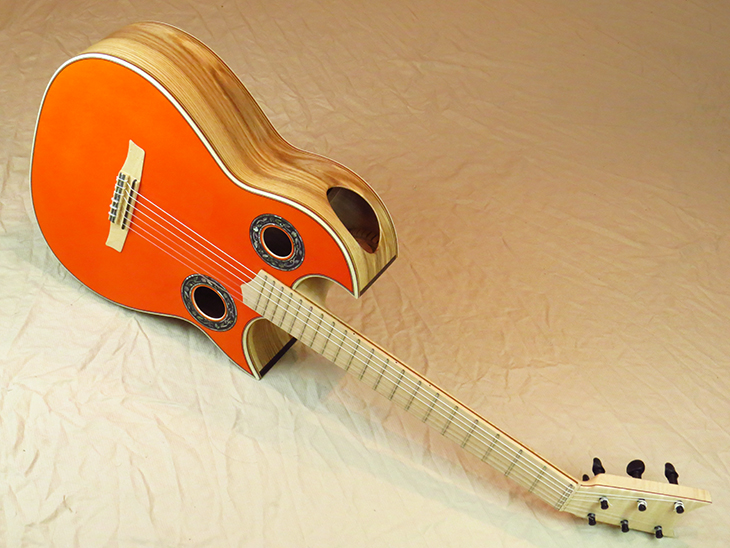 |
||||||
| G) The expanded treble sound hole (Picture taken from: http://andalusianguitars.com/FS1932-9-13.html) | ||||||
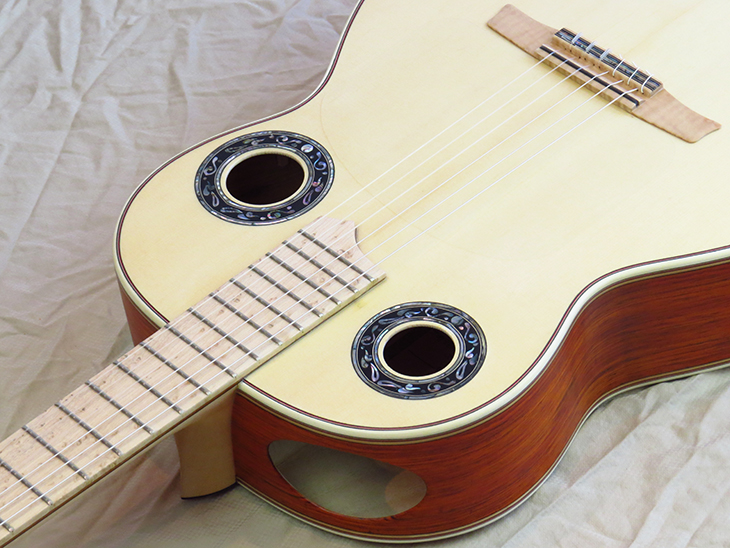 |
||||||
| I would like to emphasize that for the style we play, which could be called a “Post Paco de Lucia flamenco style” (next you have an example of that): | ||||||
| This music is related to Paco de Lucia’s aesthetics in harmony, up to concepts like chromatic lines an area not very explored so far. Like in the next video: | ||||||
| I (and some of my students) perform following Paco’s technique and posture traits as best as possible. I think it's just evident that to play such music we require a very different kind of instrument compared to that which was used seventy years ago by Paco’ s predecessors in flamenco. Players like Sabicas 1912-1990 and Niño Ricardo 1904-1972 couldn’t be more different to us in everything, starting by how they hold the guitar, their posture, sound, way of attack etc. | ||||||
| It is ironical -and often largely overseen- the fact that in Spain at present too many flamenco players are still using the same kind of out-of-date guitars as those used in the 40s, and, if you analyze in detail, you will observe that many are also performing inside the old-school parameters and referential traits regarding posture as we can see from their ways and their angle of attack in “picado” besides many other aspects of technique. For instance, playing “picado” (scale playing) you can see everybody is mostly using the old-school right hand angle of attack-posture, the old-school way to flex the finger joints: |
||||||
| It's obvious all this things are just the opposite of Paco de Lucia’s technique , please watch the next video | ||||||
| In other words I haven’t seen even one single player in Spain today who really plays, at least regarding “picado” playing (I mean posture wise speaking), in adherence to Paco’s technique, rather, at best, they all have a chaotic mixture of both techniques, the old one and the new one without even noticing what is what. I believe that personal exploration over many of this concepts have much value to improve our playing day by day, as it was Paco himself who pointed out to me all those unobvious aspects of his technique, although it was long time ago, today those things still proved to help my playing and the playing of my students or of anyone who follows that. If you are interested, on the next video I enumerated 18 aspects to advance in “picado”: |
||||||
To conclude this chapter and to convey the magic sound of the Simplicio’s AG modern guitars, the next video is a recording of an arrangement I elaborated for 3 guitars, percussion and three singers, a piece recorded in multiscreen format as my personal homage to Paco. |
||||||
| Top | Next | |||||